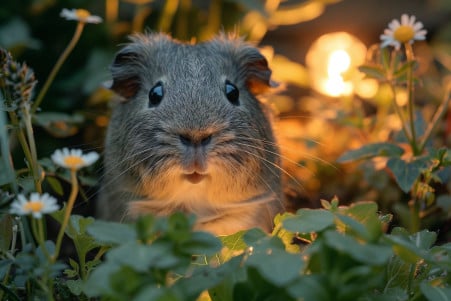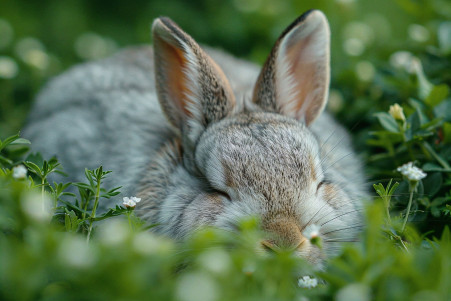Do Rabbits Have Night Vision? Exploring Their Ability to See in the Dark
10 February 2024 • Updated 11 February 2024

As the sun sets, do rabbits only see darkness, or can they see the world in shades of moonlight? Rabbits have a high rod-to-cone cell ratio in their retinas, which means they have good vision in low light, enabling them to see better in the twilight hours of dawn and dusk. However, in total darkness, rabbits depend on their other senses like hearing and smell more than their vision.
This article will take a deep dive into the fields of zoology and veterinary science to find out how well rabbits can see at night. This investigation will cover physiological research that explains rabbits’ visual systems and behavioral research that shows how rabbits behave in the hours between light and dark.
This will help you understand how rabbits use their senses to adapt to their surroundings, giving you a well-rounded view of these interesting animals.
Do rabbits have night vision?
Looking Through the Eyes of a Rabbit
Rabbits see the world in a way that’s quite different from humans, and their vision has evolved to meet their specific needs.
The way a rabbit’s eyes are set up is meant to help them stay as safe as possible in the wild. Their eyes are located on the sides of their head, which allows them to see almost all the way around themselves, or 360 degrees.
This is important because it means they can see predators from almost any direction. However, this also means that rabbits have a blind spot in front of their face, which they make up for with their other senses.
If we look deeper into the way their eyes are set up, rabbits have a higher ratio of rod cells to cone cells in their retinas than humans. This was found in a study published by S.J. Sharpe in PubMed. Rod cells are better at detecting movement and working in low light, which is why rabbits can see so well in the twilight.
On the other hand, their color vision is limited. Rabbits can only see blue and green because they only have two types of cone cells, which means they can only see a limited number of colors.
Despite these advantages, rabbits don’t have a tapetum lucidum, which is a reflective layer behind the retina that helps animals see in the dark. As a result, rabbits have poor depth perception and their vision is a bit blurry up close, which was also noted in a study by Hepper.
This shows that rabbits’ vision isn’t perfect, and it’s their other senses that help them the most in the dark. We’ll talk more about this in the next section.
Nocturnal Navigation: Using Other Senses Besides Sight
When darkness falls, rabbits must rely on their sense of hearing and their sense of smell to help them find their way. Their long ears aren’t just for listening; they are also designed to detect the slightest sounds that could signal danger or opportunity.
A study published in the Journal of Comparative Physiology A showed that cottontail rabbits have a hearing range of 300 Hz to 32 kHz, which means they can hear lower frequencies that other animals might miss. This is especially important when they can’t see as well.
Rabbits also rely on their sense of smell to help them interpret their environment, find food, and avoid predators. While their eyesight gives them a wide view of the world around them, it’s their sense of hearing and their sense of smell that help them fill in the details and create a multi-sensory map that they can use to get around in the dark.
These adaptations work together to help rabbits stay alert and aware as the sun goes down.
Twilight Tactics: Rabbit Behavior at Dusk
As the sun sets and twilight falls, rabbit behavior reflects their crepuscular nature. According to a paper published in ScienceDirect by Arias-Del Razo, rabbits are most active at dawn and dusk. This is when they forage and are most alert to avoid predators, using the dim light to help them stay hidden.
Arias-Del Razo’s research found that the behavioral patterns of rabbits and their predators are not always in sync, which gives rabbits a strategic advantage when it comes to survival.
Their ability to detect movement, therefore, becomes especially important when they need to escape from a predator during low light. Since dawn and dusk are times of changing light levels, rabbits use their motion detection skills to detect and avoid danger before it’s too late.
This is further supported by environmental conditions that affect their nocturnal behavior. A study on ResearchGate by Rodrigues shows that the presence of moonlight can change when rabbits are most active, showing how they’ve adapted to the natural light cycle.
Knowing these details about rabbit behavior during low light helps to set the stage for understanding how domestication may have impacted their vision and ability to survive.
How Rabbits’ Vision Has Changed Due to Domestication
As the domestic rabbit has become more and more comfortable in human environments, its vision has changed in ways that can be traced back to the process of domestication.
A study in PNAS by a team from Uppsala University found that domestication has led to significant changes in rabbit brain anatomy, which has in turn impacted their visual perception and fear responses.
The differences between wild and domestic rabbits are clear; wild rabbits are more vigilant, while domesticated rabbits have smaller amygdalae and larger medial prefrontal cortices, which are associated with a decrease in fear and potentially a different way of visually interacting with the world around them.
Leif Andersson’s work also suggests that domestic rabbits, which have smaller brains in relation to their bodies, likely process visual information differently than their wild relatives, who have evolved to rely on the ability to quickly flee from predators. A study in PMC found that domestic rabbits have less white matter in their brains, which could lead to slower neural processing and a less urgent perception and response to low-light conditions than wild rabbits.
These changes in brain structure and sensory processing have important implications for how domestication impacts an animal’s relationship with the world around it, including how it sees the world as the day turns to night.
Shedding Light on the Shadows: What Rabbit Vision Means
In the dim light of the evening, rabbits’ ability to see in low light is evidence of their evolutionary development. Their rod-rich eyes assist them in the twilight, but their absence of the tapetum lucidum means they cannot see in complete darkness. However, their other senses, including their sharp hearing and sense of smell, compensate for their limited vision in low light, contributing to their survival.
Throughout this article, we have explored the many ways in which rabbits’ vision has evolved and how it has impacted their other senses. Rabbits’ crepuscular behavior has shaped their vision, and their ability to detect motion has helped them survive in the wild. Meanwhile, domestication has changed their vision in other ways, including altering their brain shape and even their ability to see in low light.
In the end, the way rabbits see the world is a combination of light and dark, scent and sound, and sensitivity and survival. This comprehensive view of rabbit vision shows how their physical and behavioral adaptations have come together to help them thrive in a world that is constantly changing between light and dark.


